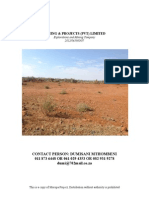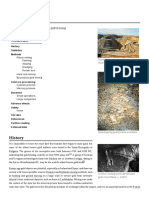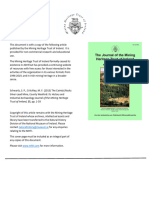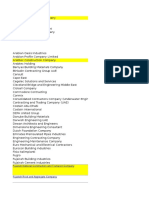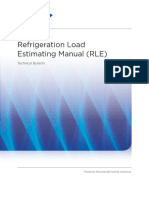Placer Gold
Placer Gold
Uploaded by
Dimi TheProCopyright:
Available Formats
Placer Gold
Placer Gold
Uploaded by
Dimi TheProCopyright
Available Formats
Share this document
Did you find this document useful?
Is this content inappropriate?
Copyright:
Available Formats
Placer Gold
Placer Gold
Uploaded by
Dimi TheProCopyright:
Available Formats
® ®
GAC AGC POPULAR GEOSCIENCE
PLACER GOLD 1
Heavy Stuff
Placer deposits are heavy minerals that, after
being weathered out of bedrock by wind or water,
are concentrated by gravity. Most people think of
gold when they hear the word 'placer', but any
1 cm
heavy mineral can become a placer. For
example, uranium, tin, and platinum can form
important placers.
R. H
erd
, NR
Can
NRCan 199558
Gold nuggets, from near Atlin, British Columbia
Gold mining with a sluice box, North Saskatchewan River, near Edmonton, Alberta, 1898
Placer Gold Formation
The first thing needed to produce a placer gold deposit is a gold-bearing source rock (sometimes called the
'Mother Lode'). The gold in this rock may be visible, or present in particles so tiny that they can't be seen with
the naked eye. Weathering gradually wears the rock away, leaving the gold, which is heavier, behind. With
just weathering and no further processing, a low-grade placer can be formed, but transportation and gravity
concentrate the gold and produce the best placers. As either rain or stream water moves over the loose gold
it is picked up and carried. Where the current slows, such as at a river bend, or where the water encounters
boulders in the stream bed, gravity causes the gold to drop out of the flow. This concentrates the gold into
'pay streaks'.
A prospector uses a pan to see if gold is present in the gravel. Swirling the
gravel with water in the pan recreates the action of a stream. You can do the
same with the palm of your hand. Pick up some beach or stream sand in
your palm and gently wash it back and forth in the water. If the sand
NRCan 21583
contains heavy minerals (for example, small dark grains or iron-rich
minerals), they will concentrate into a pay streak!
Natural Resources Ressources naturelles
Canada Canada
® ®
GAC AGC POPULAR GEOSCIENCE
PLACER GOLD 2
When and Where
Canada's placer deposits formed at different times: the placer
CANADIAN gold beaches of the Queen Charlotte Islands are recent; the
PLACER Klondike deposits in Yukon are less than five million years old;
GOLD RUSHES the Elliot Lake uranium placers in Ontario are more than two
billion years old! Older placer deposits are called
paleoplacers ('paleo' means old), and because they are
Klondike
1896 old, they sometimes have changed since they were
deposited. For example, the minerals can be
Atlin dissolved, transported, and recrystallized.
1898 Paleoplacers of gold can serve as the source
Queen
Charlotte of gold for more recent placers. Today,
Islands placer gold exploration and mining are
1852 Cariboo
1860 taking place in Canada, especially in
Fraser River
the mountains of Yukon Territory and
1858 British Columbia. More efficient
mining methods can make new
Kootenay
1864 discoveries profitable.
Chaudière River
1862
DID YOU KNOW?
Placer mining accounts for about 5% of
Canada's annual production of gold
Placer gold was discovered in beach sands near
Halifax, Nova Scotia in 1857, and along Ontario's
Vermilion River in 1896
The Klondike is Canada's richest placer gold
area: between 1896 and 1900, 77 tonnes of gold
were recovered; since then another 100 tonnes
have been found
Gold has many decorative and industrial uses,
but is also used by governments to back
NRCan 199645
currency and in trade
The Peace, Red Deer and Athabasca rivers in
Alberta contain placer gold Heading to the Klondike, 1899
Placer gold can be found along the North Saskatchewan River from Rocky Mountain House,
Alberta, to Prince Albert, Saskatchewan, a distance of over 600 kilometres
www.gac.ca/PopularGeoscience A.D. McCracken, E. Macey,
© Her Majesty the Queen in Right of Canada 2007 J.M. Monro Gray, and G.S. Nowlan
You might also like
- Nair Etal 2021 Introduction To AgroforestryDocument670 pagesNair Etal 2021 Introduction To AgroforestryRobinNo ratings yet
- Moropa Diamond Business Plan-1Document31 pagesMoropa Diamond Business Plan-1vic2clarion100% (8)
- Basic First Aid (Manufacturing & Construction) .PPT (Autosaved)Document90 pagesBasic First Aid (Manufacturing & Construction) .PPT (Autosaved)Aravind Mech100% (2)
- Mazda R26B US PDFDocument11 pagesMazda R26B US PDFIrfan Ghani100% (1)
- Rubrik Slide For Cust - 09042020Document23 pagesRubrik Slide For Cust - 09042020rshandy100% (1)
- Greenstone-Hosted Quartz-Carbonate Vein DepositsDocument13 pagesGreenstone-Hosted Quartz-Carbonate Vein DepositsLuchejo100% (1)
- The British Columbia Sediment-Hosted Gold ProjectDocument14 pagesThe British Columbia Sediment-Hosted Gold ProjectHebnerAlbertCarhuapomaRivasNo ratings yet
- Gold Mining: Gold Mining Is The Resource Extraction of Gold by MiningDocument9 pagesGold Mining: Gold Mining Is The Resource Extraction of Gold by Miningالزهراء الصغيرةNo ratings yet
- Mining and Western Settlement PatternsDocument25 pagesMining and Western Settlement PatternsRussell Hartill100% (2)
- Level Q - Gold FeverDocument4 pagesLevel Q - Gold Fevermustafa HoseinNo ratings yet
- 06 Rabb 1987 Hist Mining Az 1Document25 pages06 Rabb 1987 Hist Mining Az 1natskaNo ratings yet
- Epithermal CBDocument13 pagesEpithermal CBErvan1No ratings yet
- Placer Ore Deposit Research ReportDocument18 pagesPlacer Ore Deposit Research ReportTEN TV100% (1)
- Models Gold DepositsDocument4 pagesModels Gold DepositsDeimonNo ratings yet
- Gold HipDocument6 pagesGold Hipram211No ratings yet
- Lobo Guerrero A1Document12 pagesLobo Guerrero A1arnoldor5747No ratings yet
- Rand Refinery The Story of Gold A TimelineDocument2 pagesRand Refinery The Story of Gold A TimelinerasilingwanimariaNo ratings yet
- Common Minerals in Sedimentary RocksDocument22 pagesCommon Minerals in Sedimentary RocksAmir Al AminNo ratings yet
- Gold Rush South Australia - Find, Mines, Rewards, Locations, South Australian Gold RushDocument6 pagesGold Rush South Australia - Find, Mines, Rewards, Locations, South Australian Gold RushjesusluvsuNo ratings yet
- Kashmir SapphireDocument13 pagesKashmir Sapphirekaveh25No ratings yet
- Lode VS Placer MiningDocument2 pagesLode VS Placer MiningHannah Mae GuimbonganNo ratings yet
- Full download National Geographic Readers: Bling! (L3): 100 Fun Facts About Rocks and Gems Emma Carlson Berne pdf docxDocument40 pagesFull download National Geographic Readers: Bling! (L3): 100 Fun Facts About Rocks and Gems Emma Carlson Berne pdf docxostovehiogu100% (1)
- Geological Domain For Gold Exploration in IndiaDocument5 pagesGeological Domain For Gold Exploration in IndiadudealokNo ratings yet
- EmasDocument32 pagesEmasArdian Wijaya Iputu100% (3)
- Gold-Bearing Deposits in North-Central Nevada And: Southwestern IdahoDocument20 pagesGold-Bearing Deposits in North-Central Nevada And: Southwestern IdahoMiguel_geologistNo ratings yet
- Classification of Gold DepositsDocument342 pagesClassification of Gold DepositsHAMZA LAMSALAHNo ratings yet
- Paleoplacer: Name: Patel Karnav M. M.SC Sem-3 Guided By:Dr. Solanki Sir Paper: Gel 501 Roll No: O7Document21 pagesPaleoplacer: Name: Patel Karnav M. M.SC Sem-3 Guided By:Dr. Solanki Sir Paper: Gel 501 Roll No: O7Patel axaliNo ratings yet
- Exploration Guidelines For Gold Quartz VeinsDocument58 pagesExploration Guidelines For Gold Quartz Veinsmenekse.kazanci19No ratings yet
- 87761-Sibbald 1985 MiscRep85-4Document25 pages87761-Sibbald 1985 MiscRep85-4Swiggly PandaNo ratings yet
- Gold Mining MethodsDocument2 pagesGold Mining MethodsAlpha KiloNo ratings yet
- Placer Deposits: Submitted By: Bhaskarjyoti Rajkhowa, 5 Sem, Roll No.-07Document2 pagesPlacer Deposits: Submitted By: Bhaskarjyoti Rajkhowa, 5 Sem, Roll No.-07Day 2 DayNo ratings yet
- MDMW Gold06Document3 pagesMDMW Gold06miningnovaNo ratings yet
- The Caime Rocks Silver-Lead Mine County Wexford Schwartz S and Critchley M 2015Document40 pagesThe Caime Rocks Silver-Lead Mine County Wexford Schwartz S and Critchley M 2015Ethereal Light PhotographyNo ratings yet
- Ining Egends: Objective: To Enrich and Expand Study of Natural Resources With Literature and HistoryDocument4 pagesIning Egends: Objective: To Enrich and Expand Study of Natural Resources With Literature and HistoryMythbuster100% (1)
- Finding Placer Gold: Alberta's Capital Region River Valley ParkDocument2 pagesFinding Placer Gold: Alberta's Capital Region River Valley Parkapi-61197237No ratings yet
- SP 13Document20 pagesSP 13paulogmelloNo ratings yet
- PR OOF: Geology, Exploration, and Discovery in The Tintina Gold Province, Alaska and YukonDocument34 pagesPR OOF: Geology, Exploration, and Discovery in The Tintina Gold Province, Alaska and YukonLuis PragmahNo ratings yet
- Eldorado DredgeDocument2 pagesEldorado DredgeNeenNo ratings yet
- Au Tipo Lode 01A - GROVE e FOSTER 1991Document41 pagesAu Tipo Lode 01A - GROVE e FOSTER 1991jucieny BarrosNo ratings yet
- Gold and SilverDocument40 pagesGold and Silveraa.bacaltos123456789No ratings yet
- UntitledDocument1 pageUntitledManny WadesNo ratings yet
- SillitoeDocument19 pagesSillitoeSthefany MyaldyNo ratings yet
- Depositos SkarnsDocument13 pagesDepositos SkarnsKaren Valdivia Guillermo100% (1)
- What Are Rubies and Sapphires?Document4 pagesWhat Are Rubies and Sapphires?Shendy HingtyasNo ratings yet
- Mineral Resources and MiningDocument65 pagesMineral Resources and MiningPradeepNo ratings yet
- Downes Et Al (2004) Mineral Deposits & Models of Cootamundra 250,000 Sheet AreaDocument38 pagesDownes Et Al (2004) Mineral Deposits & Models of Cootamundra 250,000 Sheet AreaJoshLeighNo ratings yet
- Galena.Document7 pagesGalena.abualdien441No ratings yet
- Yukon Gold RushDocument8 pagesYukon Gold RushDimi TheProNo ratings yet
- Mineria en CanadaDocument14 pagesMineria en CanadaCésar VargasNo ratings yet
- Gold Report 2Document13 pagesGold Report 2Anshul GargNo ratings yet
- Gold Mining TechniquesDocument3 pagesGold Mining TechniquesDanielleNo ratings yet
- GoldDocument155 pagesGoldJeyson Cornejo100% (2)
- Dodo Industrial Proj FinalDocument81 pagesDodo Industrial Proj FinalShanthi ShanNo ratings yet
- Gold RushDocument8 pagesGold RushИнна ГаркавенкоNo ratings yet
- Metalurgia Del Oro - TraduccionDocument8 pagesMetalurgia Del Oro - TraduccionSintia Yuli Ponce AguirreNo ratings yet
- Getting Gold: A Practical Treatise For Prospectors, Miners and Students by Johnson, J. C. F. (Joseph Colin Frances), 1848Document85 pagesGetting Gold: A Practical Treatise For Prospectors, Miners and Students by Johnson, J. C. F. (Joseph Colin Frances), 1848Gutenberg.org100% (3)
- Depositos de OroDocument24 pagesDepositos de OroCarlos A Gómez PilaresNo ratings yet
- A New Geological Model For The Globe Progress Mine PDFDocument5 pagesA New Geological Model For The Globe Progress Mine PDFEfraim HermanNo ratings yet
- The Diamond Deposits of Kalimantan BorneoDocument14 pagesThe Diamond Deposits of Kalimantan BorneoDemi GanjarNo ratings yet
- The Origin and Evolution of The Klondike Goldfields, Yukon, CanadaDocument20 pagesThe Origin and Evolution of The Klondike Goldfields, Yukon, Canadageology1No ratings yet
- Clark SM 576 Service ManualDocument10 pagesClark SM 576 Service Manualvanessa100% (46)
- DH-NVR5208 5216 5232Document4 pagesDH-NVR5208 5216 5232Pardeep RajanNo ratings yet
- ?es66qnaas CC 102 Module 1 IntroductionDocument8 pages?es66qnaas CC 102 Module 1 Introductionnwgcyrb8v9No ratings yet
- K53SVDocument3 pagesK53SVCalvin Chew Kaih ManNo ratings yet
- General SpellsDocument63 pagesGeneral SpellsEmeka100% (4)
- lab 3D plotting-1Document13 pageslab 3D plotting-1ARIF K FNo ratings yet
- Data Constrution NewDocument27 pagesData Constrution NewBinduPrakashBhattNo ratings yet
- Self Elevating Jackups - Zakher MarineDocument34 pagesSelf Elevating Jackups - Zakher MarineOffshore JackupNo ratings yet
- Installer Unified Portal For RTPV Programme Manual Ver 1.4Document22 pagesInstaller Unified Portal For RTPV Programme Manual Ver 1.4jaldharaNo ratings yet
- 5kaa PCDocument51 pages5kaa PCsitaramsahandsonsNo ratings yet
- TRL2604 Study NotesDocument46 pagesTRL2604 Study Notesabdessamadlotfi02No ratings yet
- Seven Principles of Universal DesignDocument8 pagesSeven Principles of Universal DesignEricson Puig EuropaNo ratings yet
- Potensi Ekonomis Tanaman Aren (Arenga Pinnata) Petani Aren Di Desa Naga Rejo Kab. Deli Serdang SumutDocument7 pagesPotensi Ekonomis Tanaman Aren (Arenga Pinnata) Petani Aren Di Desa Naga Rejo Kab. Deli Serdang SumutMak LamperNo ratings yet
- class 11 CENTER OF MASSDocument3 pagesclass 11 CENTER OF MASSdhruvthakran77No ratings yet
- WAP2100-I SeriesDocument5 pagesWAP2100-I SeriessuplexfarhanNo ratings yet
- Civil Enforcement Handbook V 2Document56 pagesCivil Enforcement Handbook V 2Olaf RazzoliNo ratings yet
- Photoemission Optical BenchDocument2 pagesPhotoemission Optical Benchhobad57099No ratings yet
- MMS Policy Brief - 12 July 2022 - IGI MMS TAG - FNLDocument4 pagesMMS Policy Brief - 12 July 2022 - IGI MMS TAG - FNLNelis ImanningsihNo ratings yet
- Untranslatability PDFDocument9 pagesUntranslatability PDFAnna UssNo ratings yet
- Head Lice Research CHAPTER 1Document5 pagesHead Lice Research CHAPTER 1danieljudeeNo ratings yet
- Environmental Conservation Law 2012 PDFDocument14 pagesEnvironmental Conservation Law 2012 PDFThein Zaw OoNo ratings yet
- HP-480 HoribaDocument71 pagesHP-480 Horibabsfs2021No ratings yet
- Grayscale Supercell ManualDocument6 pagesGrayscale Supercell ManualNicola Dal saccoNo ratings yet
- Progressive Aspect of The VerbDocument17 pagesProgressive Aspect of The VerbKAREN ERICA MARNo ratings yet
- Solution: Answered 1 Year AgoDocument1 pageSolution: Answered 1 Year AgoMustafa MaherNo ratings yet
- KRACK Refrigeration ManualDocument54 pagesKRACK Refrigeration Manualjcastell100100% (1)

